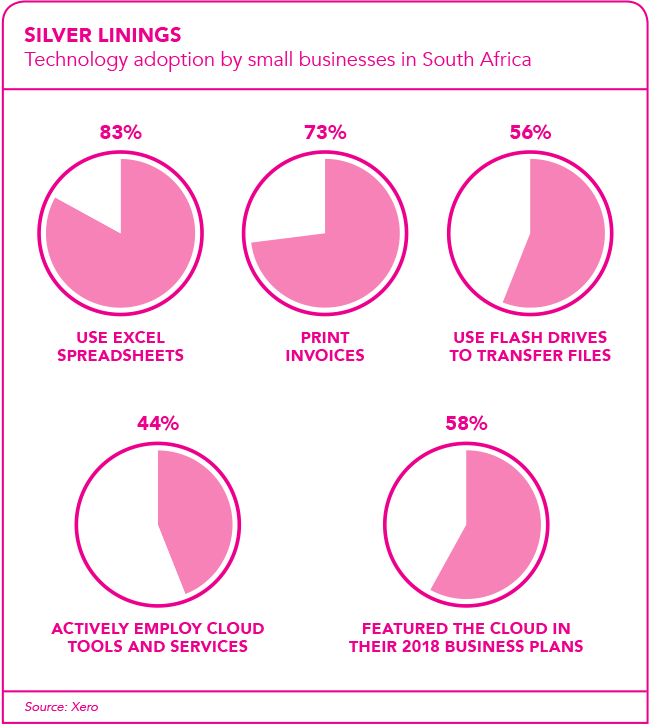Use of the cloud has exploded across the world. And while that’s the kind of attention-grabbing opening line employed by many tech writers, it really is true. According to Rightscale’s 2018 State of the Cloud survey, 96% of respondents use the technology, with public cloud adoption growing year-on-year from 89% in 2017 to 92% in 2018, and private cloud adoption growing from 72% to 75%. Meanwhile, the Cloud Africa 2018 report, compiled by F5 and World Wide Worx, claims that in three key African markets (Kenya, Nigeria and South Africa), use of the cloud among medium and large organisations has more than doubled in five years. While the report states that fewer than 50% used the cloud in 2013, it adds that ‘in 2018, use is pervasive’.
Well … sort of. Because while it’s true that use of the cloud has exploded among larger organisations, South Africa’s small businesses are, to an extent, still playing catch-up.
A recent report published by online accounting software providers Xero – which surveyed more than 400 SME owners across 25 distinct local markets – found that 56% of surveyed SMEs are still not using the cloud.
‘Small to medium enterprises typically handle and store a lot of client information,’ says Marius Maritz, department manager for Cloud Protect at Gabsten Technologies. ‘However, many still rely on traditional storage methods like keeping data on one’s computer, a flash or external hard drive, or on a server.
‘Small businesses are also at risk of data loss, whether due to malware or due to human error. It’s imperative that these businesses realise the importance of their data and the consequences of losing it. ‘The likelihood is that many businesses are still unaware of the benefits of cloud and what it involves,’ adds Maritz.
It’s an opinion shared by Craig Mitchelmore, head of Intervate North at T-Systems company Intervate. ‘One of the drivers of cloud migration is accessibility to cloud business systems like Microsoft Office 365 [O365],’ he says. ‘The idea of accessing office tools such as Word, Excel and others from anywhere and at any time, and the flexibility to add and remove users as required, is attractive. However, many businesses using the MS Office suite historically installed onto their employee laptops simply haven’t yet seen the benefits of moving to the O365 cloud platform.
‘Companies often find themselves stuck in the rut of only making use of the solutions that they are familiar and comfortable with,’ says Mitchelmore. ‘Even organisations that migrate to O365 tend to stick to using the same tried-and-trusted programmes that they previously used on their regular Office suite, not realising that an entire business productivity and collaboration toolset lies at their fingertips, if they only tapped into it and had the courage to experiment with the magic of O365 in its entirety.’
He argues that ‘a combination of fear of the unknown and a general lack of awareness of the true power of O365’ – or, for that matter, any cloud-based productivity suite – are keeping many of those organisations stuck in their comfort zones. ‘The fear stems more from the over-abundance of new, unexplained software and updates that many users find themselves inundated with on a daily basis,’ he says. ‘When users are informed and taught about the possibilities and benefits of a new way of working collaboratively, it’s easier to take new approaches on board and with far more enthusiasm.’
The F5 and World Wide Worx Cloud Africa 2018 report was based on interviews with 300 IT decision-makers at medium and large enterprises in Kenya, Nigeria and South Africa. As the report’s authors point out, ‘the cloud is not a country’. Indeed, the technology has now reached a point where its benefits are being experienced differently in the various regions. For instance, the report found that the cloud is regarded as ‘critical’ to service apps in 68% of Nigerian and 67% of Kenyan companies; but just 40% of South African companies. Meanwhile, 43% of the South African companies surveyed said the cloud was critical to HR apps; compared to just 19% in Kenya and 10% in Nigeria.
Yet while it’s being used differently, for different applications in different regions, cloud usage is undoubtedly on the rise in Africa. According to the Cloud Africa 2018 Report, 90.4% of Kenyan companies surveyed had increased spending on cloud computing in the past year, with 98% committing to increasing cloud spend this year. In Nigeria, those numbers were 78% and 94% respectively; and in South Africa 73.9% and 83%.
Against the backdrop of that increased spending, RightScale’s survey asked its 997 worldwide respondents about wasted spend. The respondents estimated 30% waste, while RightScale’s own research measured actual waste at 35%. This, naturally, puts a spotlight on costs.
‘The cloud offers many benefits,’ says Maritz. ‘But for small businesses, where every spent cent counts and maximising outputs are crucial, these benefits are even greater.’ In addition, cost savings are not the only benefits of cloud technology, he notes. This is borne out by Xero’s report, which shows that almost 50% of the businesses surveyed experienced improved efficiency, while more than a third said that the cloud improved their business continuity.

Maritz says that bookkeepers and accounting firms are among the SMEs that could benefit from the cloud. ‘[It] provides the ideal platform for bookkeepers to securely store and back up their clients’ data, allowing for easy, central access while protecting data from cyber criminals,’ he says. ‘Although no platform is 100% secure against cyber crime, the cloud is safer than hosting data on an internal server or laptop and offers the added benefit of backing data up so that, in the event of a data breach or loss, the business can still access their client’s information. The risk of losing a client’s data extends beyond having to redo hours of work, or request records from the client again. It boils down to reputation.
‘Financial businesses are expected and legislated to protect their clients’ data, and the consequences include losing business and paying penalties.’ And so the discussion turns – as it inevitably does – to security.
‘Cloud computing is gaining traction and, with major cloud players establishing – or committing to – a local presence, it’s only a matter of time before every business has some, if not all, applications running in the cloud,’ says Modeen Malick, senior systems engineer for MESAT at Commvault for South Africa. ‘For many organisations, concerns around cloud security are hindering their plans to move to cloud environments.’ (He’s right. Security was cited as a challenge for 77% of RightScale’s State of the Cloud survey respondents, with 29% of them considering it a ‘significant challenge’.)
Malick insists that businesses that have the right policies and processes in place to protect their own data – both in the cloud, and travelling to and from the cloud – shouldn’t let security threats hamper their cloud strategies. ‘It’s true that many new threats have emerged as more businesses take to the cloud,’ he says. ‘However, most of these threats can be avoided simply by having sufficient controls in place. For many organisations, storing data and running applications on infrastructure that they do not manage equates to vulnerabilities. But because it’s the cloud provider’s business to store their data and host their applications, they typically have more security and security skills than most businesses do for their on-premises solutions. It’s their business to invest in protecting their customers’ assets.’
According to Malick, one of the biggest misconceptions about cloud security lies in who is responsible for data protection: the customer or the cloud provider?
‘While the cloud provider is responsible for ensuring their infrastructure is secure, the onus falls on the customer to ensure their data is protected, and that the cloud provider’s security measures align with the customer’s security requirements,’ he says. ‘Businesses retain the responsibility for what they put in the cloud and how they access it.’ And as businesses of all sizes continue their migration to the cloud, the question of how they use it – and what they use it for – is becoming more and more interesting, and more and more complex.





